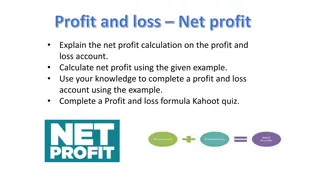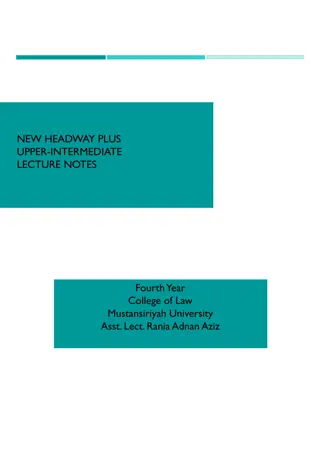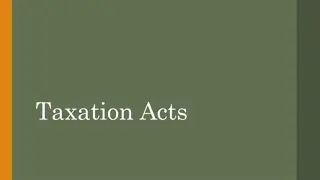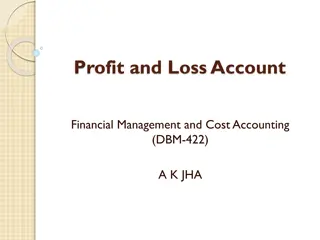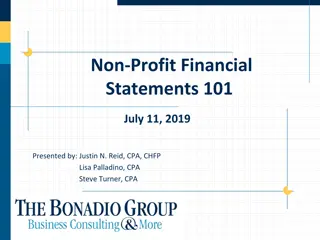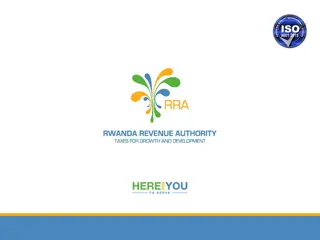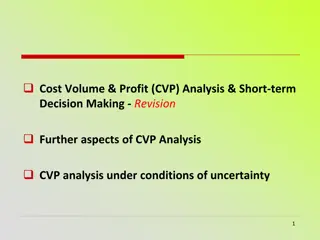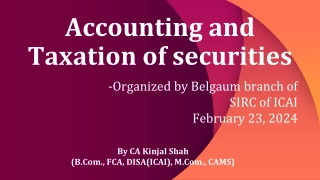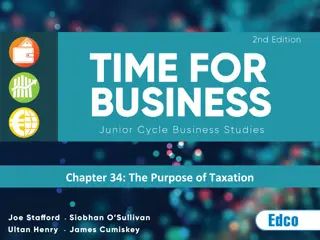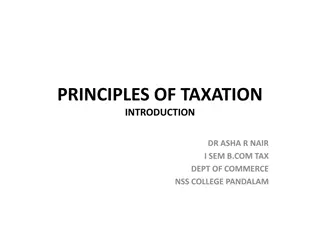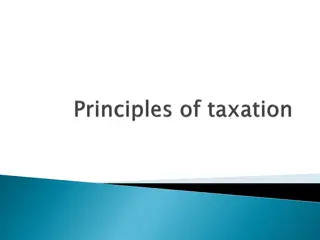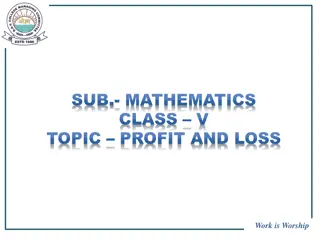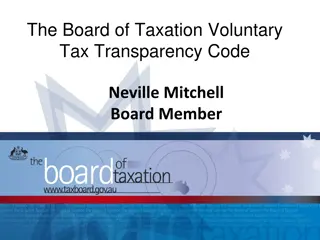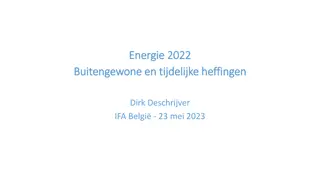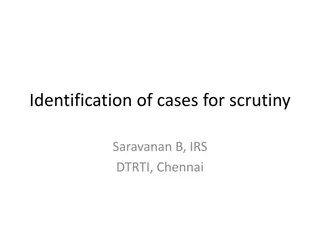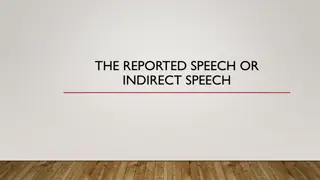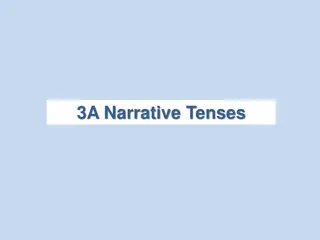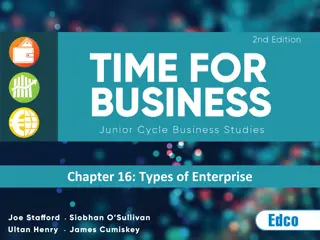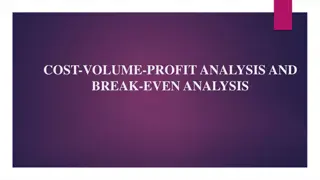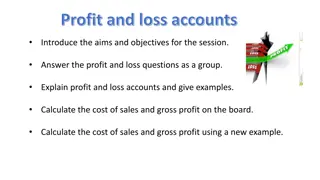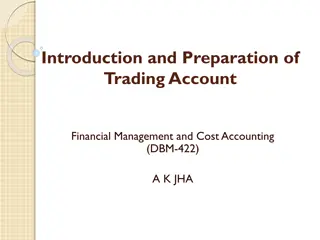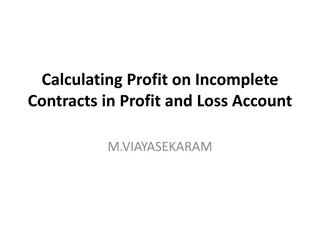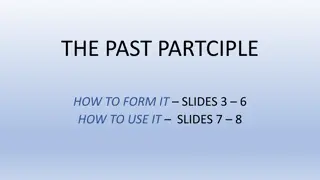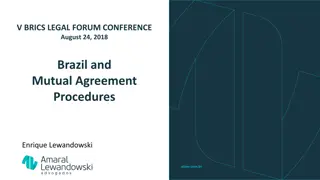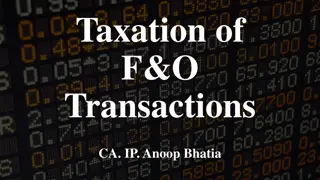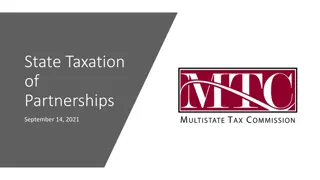Windfall Profit Taxation: Past, Present, and Future
The presentation discusses windfall profit taxation measures in Europe, specifically in Italy, comparing the old Robin Hood tax with new contributions. It explores the aims, issues, tax rates, and bases of windfall profit taxation, highlighting its redistributive purposes and challenges in constitutionality and effectiveness.
Download Presentation

Please find below an Image/Link to download the presentation.
The content on the website is provided AS IS for your information and personal use only. It may not be sold, licensed, or shared on other websites without obtaining consent from the author. Download presentation by click this link. If you encounter any issues during the download, it is possible that the publisher has removed the file from their server.
E N D
Presentation Transcript
WINDFALL PROFIT TAXATION AND THE REDISTRIBUTIVE ISSUE: PAST, PRESENT AND FUTURE Comparing Windfall Profit Tax with Robin Hood Tax Eleonora Addarii and Valentina Passadore Made to Last? Windfall Profit Taxation in Europe (and Beyond) University of Ferrara - 9 March 2023
Summary of the Presentation The actual economic situation brought back into the focus of tax policy the introduction of windfall profit taxation measures Recently, Italy set 2 different extraordinary contributions which aim to contain the effects of the increase in prices in energy and oil for businesses and consumers Back in 2008, Italy had a similar provision (the Robin Hood tax), declared unconstitutional by the judg. 10/2015 that declines the main criteria to evaluate windfall profit taxation according to Italian Constitution The comparison between the old Robin tax and the new contributions shows that despite the differences and the caution used by the lawmaker, defining a windfall profit tax really effective and constitutionally legitimate is still an unresolved issue 1
Windfall profit taxation? Purposes and issues A. The aim: generate revenue to finance extraordinary and emergency expenses, prevent the accumulation of extraordinary profits for a few beneficiaries, prevent speculative behaviours and reduce the pressure that the increase in energy costs has on citizens and businesses B. The issues: selective and potentially discriminatory measures contrast with the rules on competition and state aids Particular attention needed in the formulation of the rules and the structuring of the tax (taxable persons and tax base) in order to achieve the solidarity and redistributive purposes that justify the different taxation 2
Windfall profit taxation in Italy art. 37 D.l. n. 21/2022 Tax rate: 25% (at first, 10%) Tax Base: increase between the balance of active and passive VAT operations in the periods October/April 2020 and October/April 2021 IF over 5mil euros in any case higher than 10% Taxpayers: all subjects operating in the field of production, resale, distribution and marketing of energy, gas and oil products or if at least the 75% of the revenues derives from such activities (refer to VAT law) Non-deductible 3
Windfall profit taxation in Italy art. 1 co. 115-119 L. n. 197/2022 Tax rate: 50% (the amount due should not exceed 25% of the company s equity/net assets in 2021) Tax Base: share of global income 2022 which exceeds at least for the 10% the average income of the 4 previous tax periods (2018-2021) Taxpayers: all subjects operating in the field of production, resale, distribution and marketing of energy, gas and oil products or if at least the 75% of the revenues derives from such activities. Does not apply to micro and small companies in the oil distribution field (refer to IRES) Non-deductible 4
Windfall profit taxation in Italy and other extraordinary measures in the past Robin Hood Tax: windfall profit taxation for oil and energy companies (Unconstitutional) Income tax surcharge for financial managers & executives on bonus and stock options (Legitimate) Income tax solidarity contribution for individuals over 300.000 (Never questioned) Solidarity contribution on pensions over 90.000 (Unconstitutional) Income tax surcharge for banks and insurance companies (Legitimate) 5
Windfall profit taxation in Italy ROBIN TAX art. 81 D.l. n. 122/2008 Tax rate: 6,5% (at first 5,5%) Tax Base: IRES taxable income Taxpayers: all subjects operating in the field of production, resale, distribution and marketing of energy, gas and oil products or with prevalent revenues deriving from such activities. - over 25 mil revenue - over 10 mil revenue and 1 mil net income - over 3 mil revenue and 300.000 net income Prohibition of economic transfer on prices 6
Robin tax and C. Cost. n. 10/2015 the starting point The provision of selective tax measures that introduce a discipline limited to economic sector/type of taxpayer is not to be considered illegitimate in itself nor in violation of constitutional principles The peculiarities of the energy and oil market can in itself constitute a valid reason for the provision of a differentiated tax treatment (oligopoly, anelastic demand, difficult access) The occurrence of a particular economic situation can constitute a valid reason for the introduction of more burdensome tax measures limited to certain subjects For the restriction of the principles of equality and ability to pay to be considered legitimate, it is necessary that the structure of the tax is consistent with the ratio that justifies it 7
Robin tax and C. Cost. n. 10/2015 the conclusion Robin tax is illegitimate: for the determination of the tax base, because it affects the entire income of the company, completely lacking of a mechanism that allows separate taxation of excess profits from a duration point of view, as it is structured to be permanent not suitable for the aim of solidarity and wealth redistribution, because the mere ban of the economic transfer is not able to prevent the downstream of the burden It is unreasonable because it targets the whole business income, does not provide an ending linked to the economic conditions, does not guarantee the fulfilment of the redistributive purpose not preventing the transfer of the burden on prices and consumers 8
New windfall profit contributions in the light of C. Cost. n. 10/2015 Same taxpayers as Robin tax: on this grounds both the contributions are legitimate (except for the possible discrimination within the same group of taxpayers) Different tax base from Robin tax: neither of them is able to identify excess profits 2022 contribution: refers to Vat operations in a given period 2023 contribution: refers to global income Limited duration: at the moment, both the contributions are intended to be extraordinary and levied for just one tax period each 9
Suitability to satisfy the solidarity and redistributive purpose Lack of an effective prohibition to transfer the burden to prices and consumers 2022 contribution: provides for AGCOM to supervision the prices and imposes on the companies involved the obligation to monthly communicate the prices: - No sanctions/sanctioning powers for AGCOM - No predetermined criteria to evaluate the prices or the margin applied/realized - Information required different from tax base (purchase&sale prices vs VAT operations balance) - Too many differences in the market (energy/gas vs oil) 2023 contribution: no provisions at all 10
. No deduction within IRES and IRAP Increases the risk of transferring the economic burden, as the contributions represent a cost for the company. 2022 Contribution: violation of the principle set by C. Cost 262/2020: all inherent costs should be deductible within income taxation (except art. 99 TUIR) 2023 Contribution: the same violation depends on the qualification of the tax (income tax or not?) On these grounds, according to the principles set by C. Cost. 10/2015 both the contributions should be considered unable to provide the means to assure the fulfilment of the redistributive purpose and avoid the transfer on prices and consumers. 11
Conclusions Do the new Italian windfall profit taxes pass the test? Despite many differences with Robin tax, the new contributions would be able to pass the examination of the Court probably only from a duration point of view. 2023 contribution represents a step forward in identifying the excess profit that justifies the different tax burden The absence of the prohibition to transfer on downstream prices and consumers and the impossibility of carrying out effective controls endangers the actual possibility to achieve the objectives outlined Is this type of evaluation really effective in order to determine whether this kind of taxes is legitimate from a constitutional point of view? 12


